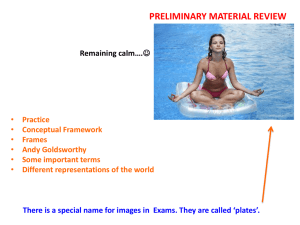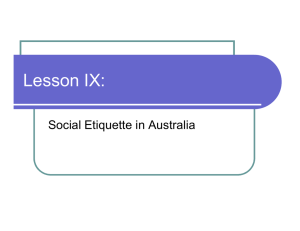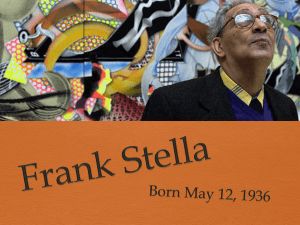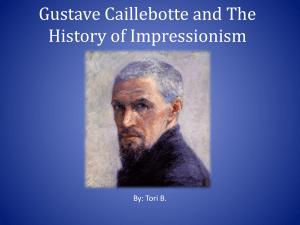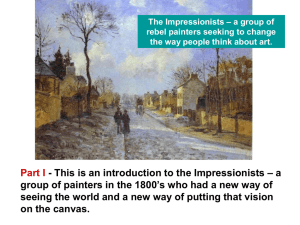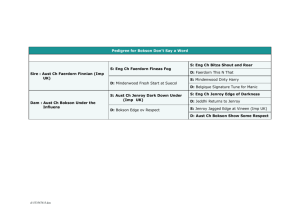LANDSCAPE V - General Education @ Gymea
advertisement
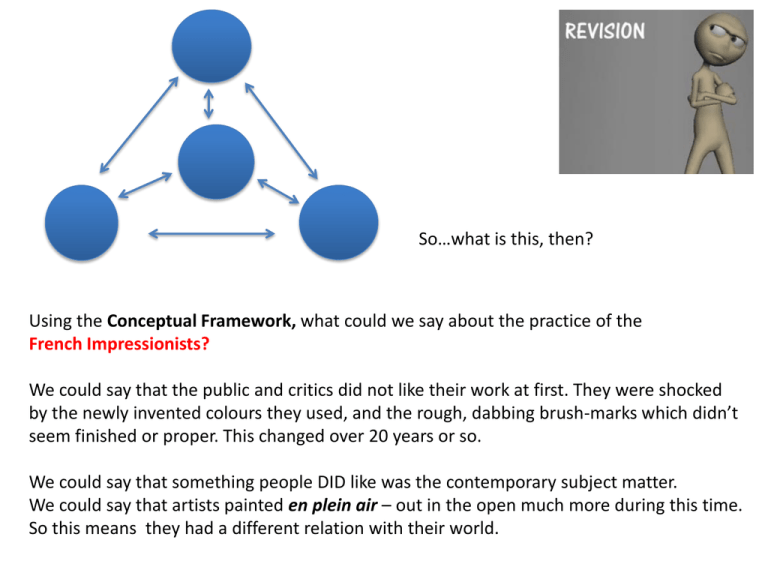
So…what is this, then? Using the Conceptual Framework, what could we say about the practice of the French Impressionists? We could say that the public and critics did not like their work at first. They were shocked by the newly invented colours they used, and the rough, dabbing brush-marks which didn’t seem finished or proper. This changed over 20 years or so. We could say that something people DID like was the contemporary subject matter. We could say that artists painted en plein air – out in the open much more during this time. So this means they had a different relation with their world. LANDSCAPE V – Australian Impressionists (the Heidelberg School.) At the end of the 19th century, artists in Australia were experimenting with new technologies and approaches, just like the French Impressionists. They were aware of some of the art trends in Europe. A group of Melbourne-based artists became known as ‘the Heidelberg school’ as they spent time painting there. (Heidelberg is about 15 km away from the centre of Melbourne and now a Melbourne suburb.) Jane Sutherland (Aust.1853 – 1928) Field Naturalists, oil on canvas, 1896. What can we say about this painting, using the Structural Frame? (The Structural Frame considers compositional elements; symbols/signs; Art movements.) Towards the end of 19th century, there was a growing sense of Australia as a nation rather than a group of colonies. There was the celebration of the Centenary of white settlement (1888) and moves towards Federation (1901.) The Australian Impressionists were interested in this idea of what it means to be Australian. The way landscape, both rural and urban, is represented, influences how people see themselves, and think of themselves. This is another example of our Conceptual Framework at work. The paintings of the Australia Impressionists were very popular and have remained so. Part of the reason for this is that people enjoyed the way Australia was being described. They liked the ideas behind the artworks. Using the Cultural Frame, what could we say about this painting? Arthur Streeton (Aust. 1867-1943) Golden Summer Eaglemont, 1889, oil on canvas, 81cm x 152cm Plein air painting, mentioned last session with the French Impressionists, was adopted by the Australian artists of this period. This work by Tom Roberts is of a contemporary activity becoming popular for Melbourne people - going for a sail. What could be the implication of describing a leisure activity? What is this saying about the artist’s world? Tom Roberts (Aust.1856-1931) The Slumbering Sea, Mentone, 1887, oil on canvas, 51 x 76 cm Using the Cultural Frame, we could note something about the figures in this image. Initial sketch for the painting, 1888, gouache on brown paper, 22 x 30cm. http://www.ngv.vic.gov.au/explore/multi media/view/?mediaid=571212&playlistid =570970 Tom Roberts (Aust. 1856-1931) Shearing the Rams,1890, oil on canvas, 122 x 183cm Here, we again see the artist describing a contemporary scene, but this time it’s hard work. This work was created to celebrate Australia’s Centenary of settlement. There was enthusiasm for all things Australian. The idea of a world of healthy, tough men working together – being mates – was a popular theme in Australia. Although this work was in fact very carefully composed, it has a sense of realism and naturalism. Roberts was truly trying to capture the scene, and include the bright Australian light. Arthur Streeton (Aust. 1867-1943) Spirit of the Drought, c.1895, oil on wood panel 35 x 37 cm What on earth is this naked woman doing in the landscape? What are we to make of this? . This is a contemporary subject (drought in Australia) but the artist has used allegory, that is, used a human figure to describe a concept. However his rough treatment of the landscape itself, with emphasis on the colour and lack of careful detail, as well as the way he has described the figure, with minimal modelling, is Impressionist in style. Notice the complementary colours of the violet sky and yellow grasses. This image is both beautiful and sinister. The artist took this large canvas and painted this en plein air. He was perched on a rock ledge to capture this odd, photographic-style perspective. (Note how high the horizon line is.) The scene is of a railway tunnel that was being created by blasting rock away with explosives. The phrase ‘fire’s on’ was yelled as a warning before a detonation occurred, so everyone could take shelter. While Streeton was painting, there was a unexpected explosion and a worker was killed. Streeton ended up painting his body being brought out from the tunnel and family waiting for his body to come out. Arthur Streeton (Aust. 1867-1943), Fire’s on, 1891, oil on canvas 184 x 122 cm Using the Structural Frame, what can we say about this artwork? This work describes a gold prospector who has not found any gold, therefore is ‘down on his luck’ or unlucky. It has been painted mostly plein air, and McCubbin used a friend as the model. Gold mining was a significant part of Melbourne’s history and wealth. This image caught the imagination of Australians who were then, as now, mainly urban dwellers rather than ‘bushies’. There was an idea of the prospector being ‘his own man’, having freedom to make his own decisions, even though today he didn’t find any gold. This was a kind of myth which people liked to believe in. Again we see the use of a contemporary subject. The figure is actually very detailed and carefully modelled however so this part of the painting was probably done back in the studio. Fred McCubbin (Aust.1855-1917) Down on his luck, 1889, oil on canvas,145 x 183x 14cm (framed) ,
